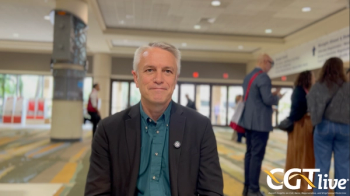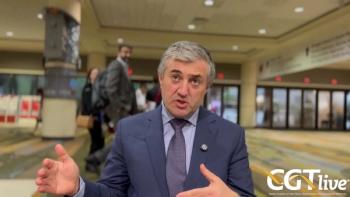
Bringing HLA-A*02-directed CAR T to Solid Tumor Care With the EVEREST-1 Trial
Diane M. Simeone, MD, discussed the phase 1/2 EVEREST-1 trial, which seeks to assess the novel CAR T-cell therapy A2B530 in patients with solid tumors—hopefully progressing one-and-done engineered therapies in this population.
This content originally appeared on our sister site, OncLive.
Challenges have waylaid progress in the development of chimeric antigen receptor (CAR) T-cell therapies for solid tumors, but the upcoming phase 1/2 EVEREST-1 trial (NCT05736731)—which will evaluate the novel agent A2B530 (A2 Biotherapeutics)—is seeking to push progress for one-and-done engineered therapies in this arena.1
A2B530 is designed to target carcinoembryonic antigen (CEA), an antigen expressed in many solid tumor types—particularly in pancreatic and lung cancers. Although, CEA is also present in some types of healthy cells, such as gut epithelial cells, which has created a challenge of needing to address potential on-target, off-tumor toxicity.2 As such, A2 Biotherapeutics has developed a novel logic-gated T-cell platform, called Tmod, to help the agent differentiate between cancer cells and healthy cells.
The CEA-directed Tmod construct of A2B530 utilizes the LIR-1-based inhibitory receptor that targets HLA-A*02; this inhibitory receptor—also referred to as a blocker—is then able to distinguish between healthy and cancer cells by recognizing the loss of heterozygosity of HLA-A*02 that is present on tumor cells.2
In an interview with CGTLive™'s sister publication, OncLive®,
Simeone expressed her excitement about the opportunity presented by EVEREST-1, particularly in determining the best deployment for the therapy. She hopes A2B530 may be able to broaden the portfolio of patients that will be eligible for treatment by improving the activator portfolio and the trial eligibility of HLA subtypes.
Are there barriers to providing effective CAR T-cell therapies for patients with solid tumors?
There have been unique challenges in solid tumors, [including] understanding the tumor microenvironment. For the tumor that I study, pancreatic cancer, that's been a particular challenge due to difficulty in tissue acquisition. However, with increasing analysis of human tumors, in particular with the burgeoning field of single-cell sequencing, we're getting a much more detailed look into the microenvironment of solid tumors and that is going to help us drive new technologies in immunotherapy.
With CAR T, there are advances in the technological aspects of T-cell preparation, targeting strategies, [and] strategies to mitigate off-target effects. The combination of these things coming together is hopefully poising us to move CAR T-cell therapy into effectiveness for solid tumors.
What research established the foundation for the EVEREST-1 trial?
The concern for patients is if they undergo a tumor resection [and] have a recurrence, what therapeutic options [are] available to them? As we first built out BASECAMP-1 [NCT04981119], we studied patients who underwent surgical resection who might be at high risk for recurrence, and that included patients with pancreatic cancer, high-risk colon cancer, and lung cancer. With those analyses, we looked at HLA status of the patient and HLA status in the tumor—that allowed us to assemble a group of patients that, if they were to develop recurrence, would have a very viable and attractive therapeutic option.
Now that EVEREST-1 is opening at several sites around the country we can broaden access to patients across a range of tumors, growing to include ovarian, head, and neck, that have the correct HLA subtype, HLA-A*02—which is the most common HLA subtype in the United States. This represents a remarkable option for therapy. Of course, an important second part of qualifying for the trial is to have a loss of heterozygosity of the HLA second allele in the tumor and that allows the CAR T to be very effective in treating the tumors with a high level of selectivity.
How was the trial design of EVEREST-1 informed by the BASECAMP-1 trial?
The design was crafted to reflect 2 parts. The foundation is BASECAMP-1, which [aims] to identify patients around the country who qualify for entry in the study, and then EVEREST is [assessing] the ability to deliver CAR T-cell therapy to selected patients.
We wanted to be quite broad in our approach to identify patients around the country who were eligible with BASECAMP-1 because there are some defining criteria that may not apply to all patients. There is a gradual plan to broaden the HLA subtypes that will be available for this type of therapy. For now, it's for HLA-A*02, that's going to be about 30% of the US population and from there there's going to be a subset of patients that have a loss of the second HLA allele in their tumor. So, there is a funneling effect of who may be eligible.
[However], this is a great start, and certainly, as the approach broadens, there'll be different activators or antigens expressed on the cell surface that [will] broaden the number of patients available. Importantly, [there will be more] approaches to mitigate the off-target effects so that you can deliver a high payload while mitigating some of the problematic [adverse] effects [AEs] that have happened with CAR T therapies for patients with solid tumors in the past.
How does A2B530 differ from the CAR T-cell agents that have already been tested in solid tumors?
The approach is really focused on safety and there are a number of different elements that are built into the constructs that are unique to A2B530. They spent a lot of time modeling how to optimize the CAR T generation for effectiveness and validating those results in in vitro and in vivo models.
Importantly, both a blocker and activator are built in the same construct, such that the T cells will only target cells that have a loss of HLA—that's a critical component. We have witnessed very heroic attempts to try to use CAR T in solid tumors, but we have seen that there can be some significant AEs. This approach has the ability to deliver a high payload but mitigate some of these problematic AES.
It’s a new approach and we’ll take all the learnings from prior CAR T studies [into consideration]; the team that will be administering the CAR T and overseeing how the patients do during treatment and afterwards are experts. I am a pancreatic cancer surgeon and clinical trials researcher, so I don't personally have experience treating patients with CAR T therapy, but importantly, we have a very robust team. We'll have individuals with expertise in the specific diseases that are being treated and also [clinicians] on the team [with] expertise in CAR T therapy and all the nuances of executing treatment and mitigating any other AEs that may occur.
How might EVEREST-1 affect the treatment paradigm for the solid tumor patient community?
I had a conversation with Will Go, MD, PhD, who is the chief medical officer [at A2 Bio], approximately 4 years ago and I [mentioned that finding] more effective therapies for pancreatic cancer is a holy grail. Pancreatic cancer has been particularly recalcitrant to immunotherapy and I asked Will to reach out to me when he thought that there might be something viable in the immunotherapy space that pancreatic cancer patients might be eligible for.
He reached out as this concept got developed, and in looking at the pretty compelling preclinical data and the robustness of the scientific strategy, I thought this really had a chance. Of course, the proof is always in the pudding and we'll have to see what the results are in patients, but we have the opportunity to provide something very unique. Our goal is also to learn from patients on trials and to partner the clinical trial with some very robust translational science so that we can understand the penetrance of the CAR T cells into the tumor and how that affects patient responses.
What are some lingering questions that could remain unanswered after the completion of EVEREST-1?
Is this kind of therapy alone sufficient? Will there need to be any sequencing with this kind of therapy? Does prior chemotherapy have any effect on the effectiveness of this therapy?
We're learning from our single-cell work that prior chemotherapy may in fact be immunosuppressive in function, so we may want to give some thought on how we best deploy this therapy. [In EVEREST-1], it's being deployed in patients who have recurrent metastatic disease, but if there is some signal [of efficacy] here, we could think about its potential application in the adjuvant setting or potentially in the neoadjuvant setting. These are all open questions that need to be addressed. Importantly, we want to be in a position to learn from every patient that's on the trial and to address them effectively.
Transcript edited for clarity.
REFERENCES
1. A study to evaluate the safety and efficacy of A2B530, a Logic-gated CAR T, in subjects with solid tumors that express CEA and have lost HLA-A*02 expression (EVEREST-1). ClinicalTrials.gov. Updated February 21, 2023. Accessed May 19, 2023. https://www.clinicaltrials.gov/ct2/show/NCT05736731
2. Hecht RJ, Sandberg M, Wang X, et al. A2B530, an autologous CEA-directed Tmod T-cell therapy with an inhibitory receptor gated by HLA-A*02 to target colorectal, pancreatic, and lung cancer. J Immunother Cancer. 2022;10:229 doi:10.1136/jitc-2022-SITC2022.0229
Newsletter
Stay at the forefront of cutting-edge science with CGT—your direct line to expert insights, breakthrough data, and real-time coverage of the latest advancements in cell and gene therapy.
















































